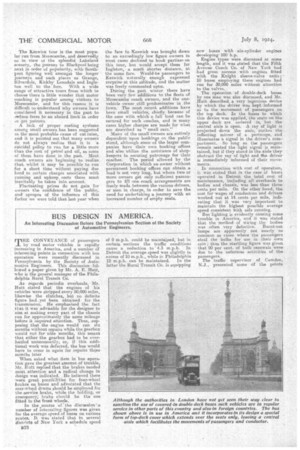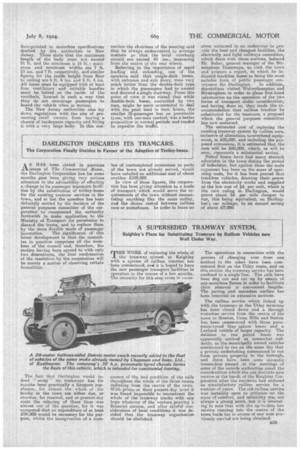BUS DESIGN IN AMERICA.
Page 24

Page 25

If you've noticed an error in this article please click here to report it so we can fix it.
An Interesting Discussion Before the Pennsylvanian Section of the Society of Automotive Engineers.
THE CONVEYANCE of passengers by road motor vehicle's is rapidly increasing in America, and a number of interesting points in connection with bus operation were recently discussed in Pennsylvania by the Society of Automotive Engineers. This discussion followed a paper given by Mr. A. E. Bute, who is the general manager of the Philadelphia Rural Transit Co.
As regards periodic overhauls, Mr. Hutt stated that the engines of his vehicles were stripped every 50,000 miles, likewise the clutches, but no definite figure had yet been obtained for the transmission. He emphasized the fact that it was advisable for the designer to aim. at snaking every part of the chassis run for approximately the same mileage before it required attention. Thus, supposing that the engine would run six months without repairs while the gearbox would run for nine months, this meant that either the gearbox had to be overhauled unnecessarily, or, if this additional work was deferred, the bus would have to come in again for repairs thee months later 'When asked what item in bus operation gave the greatest amount of trouble Mr. Hutt replied that the brakes needed most attention and a radical change in design was indicated. Be believed there
• wore great possibilities for four-wheel brakes on buses and advocated that the rear-wheel drums should he employed for the service brake, while the holding, or emergency, brake should be the one fitted to the front wheels.
In the course of the discussion 'a number of interesting -figures was given for the average speed of buses on various reutes. It was stated that in several districts of New York a schedule speed
of 9 m.p.h. could be mainteined, but in certain sections the traffic conditions cause a reduction to 4.3 m.p.h. In Detroit the average speed was slightly in excess of 10 m.p.h., while in Philadelphia 12 m.p.h. can be maintained. In the latter the Rural Transit Co. is equipping new buses with six-cylinder engines developing 100 h.p. Engine types were discussed at some length, and it was stated that the Fifth Avenue Coach Co. of New York had had great success with engines fitted with the Knight sleeve-valve units ; 10 buses employing these engines had run for 30,000 miles without attention to the valves.
The operation of double-deck buses by one man was also discussed, and Mr. Hutt described a very ingenious device by which the driver was kept informed as to the movement of passengers On the top deck. In the buses to which this device was applied, the seats on the upper deck are covered in, but the central aisle is open. A ray of light is projected down the aisle, strikes the reflecting mirror of a, periscope, and illuminates a signal in the driver's compartment. So long as the passengers remain seated the light signal is maintained, but if they stand in the aisle they obstruct the ray of light and tile driver is immediately informed of their movements.
In connection with cost of operation, it was stated that in the case of buses operated in Detroit the total cost of maintenance, including all overhauls to bodies and chassis, was less than three cents per mile. On the other hand, the cost for wages of conductors and drivers worked out at 14 cents per mile, indicating that it was very important to maintain the highest possible average speed consistent with safe running. Bus lighting is evidently causing some trouble in America, and it was stated that the method of wiring the • bodies was often very defective. Burnt-out lamps are apparently not nearly so common as cases where the passengers steal the bulbs for use in their own oars; thus the startling figure was given that 90 per cent, of bulb renewals were due to the nefarious activities of the passengers. The traffic supervisor of Camden, N.J., presented some of the points •
inco,perated in motorbus specifications drafted by the authorities in New Jersey. These state that the maximum length of the body must not exceed 21 ft. and the minimum is 16 ft. ; maximum and minimum widths are 7 ft. 10 ins. and 7 ft. respectively, and similar figures for the inside height from floor to ceiling are 6 ft. 6 ins. and 6 ft. 4 ins. All buses must be equipped with at least four ventilators and suitable handles must be bolted on the inside of the vestibule, located in such a way that they do not encourage passengers to beard the vehicle when in motion.
The New Jersey authorities also lay down regulations with the aim of preventing small owners from buying a chassis of inadequate capacity and fitting it with a very large body. In this con nection the chairman of the meeting said that he always endeavoured to arrange matters so that the total overhang should not exceed 60 ins., measuring from the centre of the rear wheels.
Referring to the importance of rapid loading and unloading, one of the speakers said that single-deck buses, with entrance and exit doors, were very much better than the double-deck type in which the passengers had to ascend and descend a single stairways From this point of view it was stated that while double-deck buses, controlled by two men, might be more economical to deal with the peak load in rush hours, the smaller 25-passenger bus on pneumatic tyres, with one-man control, was a 'better proposition in normal periods and tended to expedite the traffic.






























